Rock climbing is an ever-growing sport that has been flooding the news and social media, most notably because it is set to make its Olympic debut in Tokyo 2020 (to be held in 2021). It may seem like rock climbing sprouted out of nowhere, especially if you’ve only recently noticed fitness gurus and avid gym-goers alike picking up the sport for its mental and physical challenges. But, the sport dates back to the late 19th century as an alpine sport, meant for the burliest and toughest people out there.
So, what changed? Rock climbing used to be obscure, novel, and dangerous. Now, while the danger still lingers in disciplines such as alpine climbing, the sport and the climbers themselves have evolved to make it safer, more efficient, and more accessible to the general public. With noticeable achievements such as the first ascent of Everest by the legendary Edmund Hillary and Tenzing Norgay as well as the ground-breaking feats sent by top climbers in the world such as Margo Hayes, the world can’t help but watch the spectacles that constitute rock climbing.
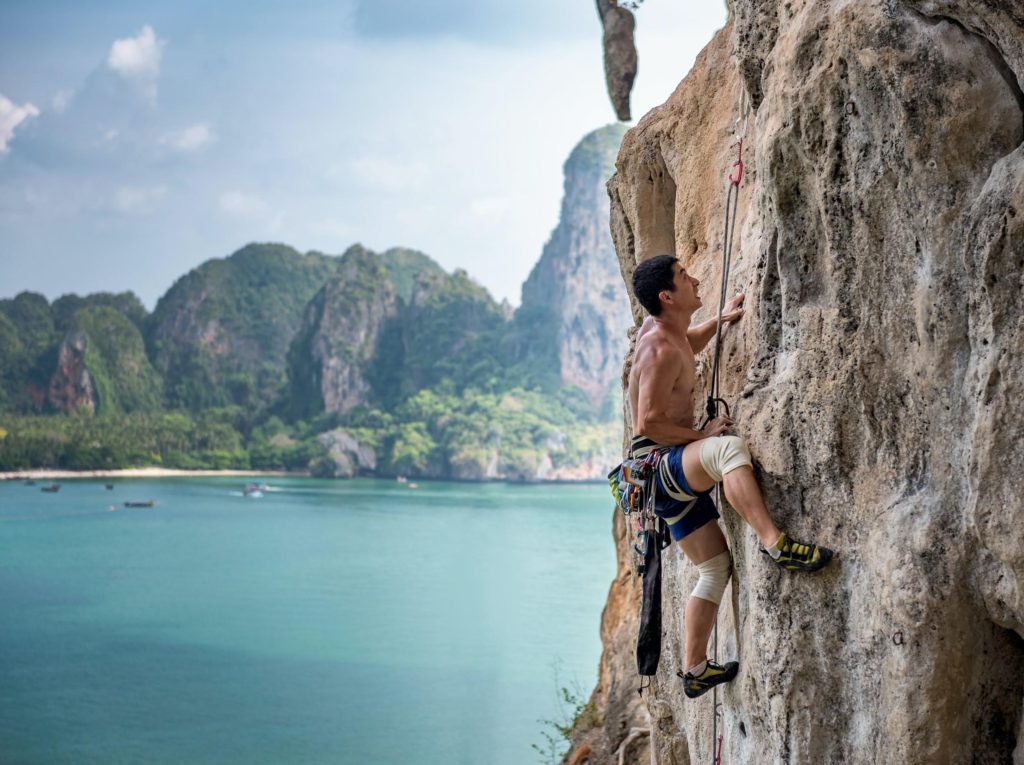
Rock climbing can sound very complicated to someone who’s not familiar with the different rock-climbing types. There’s lead, bouldering, top-rope, speed, and so on, and so on. For those who simply don’t know what form of climbing is right for them, don’t worry. I’ll be breaking down the major types of rock climbing so that you can have a better picture of what’s what. Then, you can decide what kind of climbing suits you the best.
Before we begin, I want to note that most of these climbing types can be performed both indoors and outdoors. Outdoor climbing is inherently more difficult and dangerous, whereas indoor climbing is safer because it is practiced in a more well-controlled environment. It is recommended as a beginner to climb indoors for safety reasons, and then as you grow stronger and more knowledgeable, you can transition to outdoor climbing.
Lead and top-rope climbing are similar in the physical exertion and technique required to climb. They both challenge your endurance and require you to be focused for an extended period of time. If you are afraid of heights, then lead and top-rope may not be for you when starting. The essential equipment required is a harness, a helmet if you’re climbing outdoors, climbing shoes, and a rope and a carabineer. If you don’t know what all of this equipment is, we’ll be covering them later in this article.
Lead and top-rope both require you to climb high, and both require you to be secured by a rope. There is a distinct difference between lead climbing and top-rope climbing, however. Lead climbing involves clipping yourself to bolts as you climb higher, whereas top-rope climbing already has the rope secured on the top of the climbing route, the path that you climb on the wall. The difficulty and the extra effort it takes to secure a rope on the top of an outdoor route make top-rope almost exclusive to indoor gyms.
Often, indoor climbing gyms are equipped with auto-belays, which automatically control how much slack is in the rope and properly prevent steep falls. Auto belays are great for soloist climbers who don’t have a climbing partner who can belay them as they climb. Nonetheless, asking a fellow in the climbing gym to belay you is a great way to make new friends.
Bouldering doesn’t require a rope and instead uses a mat, known as a crash pad, to break your fall. When you boulder, you usually don’t climb any higher than 4 meters above the ground. Bouldering is known as the more muscly side of climbing and is less endurance-based. This climbing is packed with more complexity, making it a puzzle to try and figure out how to climb and send the problem, which is the bouldering equivalent of a climbing route.
Bouldering is sometimes preferred over the lead and top-rope climbing for its simplicity and the little equipment required (when bouldering indoors, that is). You just have to grab your climbing shoes, and you’re good to go. Bouldering is also great for those who are scared of heights and want to ease into climbing without risking big falls.
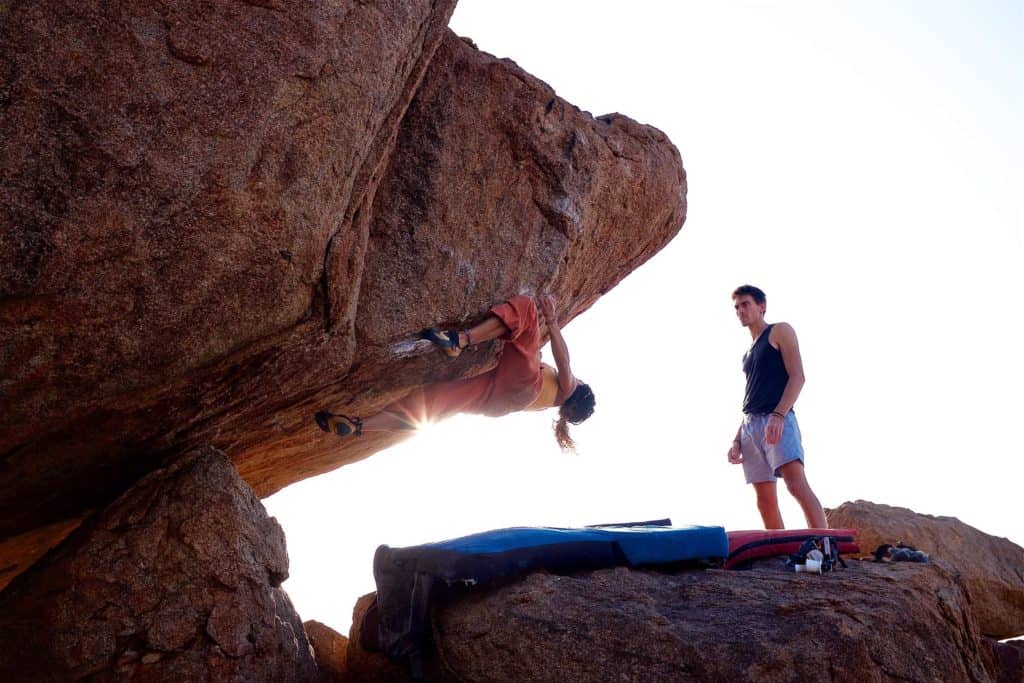
Speed is one of the newest forms of sports climbing. Often sneered at by more traditional climbers, sport speed climbing is strictly performed indoors on the same route every time. Much like sprinting on a track, you climb speed to beat your previous time and climb the fastest that you possibly can.
There is also outdoor speed climbing. But, outdoor speed climbing requires a lot of skill and expertise as it is much more dangerous. One of the most famous outdoor speed climbs was performed by Alex Honnold and Tommy Caldwell for climbing the Nose on El Capitan in under two hours, a feat that will be forever in the history books.
Traditional climbing is the term used to describe climbing on a clear rock, where we need to use climbing gear to secure ourselves while climbing up the rock. Unlike the speed climbing and the top-rope where there are readily fixed points to secure our rope to, in trad-climbing we need to fix our own device to the rock. We call these anchor points. We will show an example for this later in this article.
Mixed climbing involves both ice climbing and rock climbing. So the climber must have all the required gear and expertise for such a mixed environment.
“Free solo” climb is the most extreme version of rock climbing, where the climber actually doesn’t use any equipment or assistance for the climb.
Rock climbing offers a myriad of both physical and mental benefits. People often begin rock climbing because of the positive effect that climbing consistently can have on your health and general well-being. Everyone is different, and the impact that climbing may have on you can vary depending on the volume that you climb and your physical build.
The physical benefits of rock climbing are almost endless. Most obviously, you become stronger in your upper body. As you climb for at least a few weeks, you’ll begin to notice some more muscle definition on your back and shoulders. Your forearms will strengthen tremendously, and also your hands. If you haven’t noticed, climbers are known to have an almost ridiculous amount of grip strength.
Another physical benefit of climbing that many people don’t realize is that their toe strength will also increase. As you climb, you utilize your feet to stand on the climbing holds. Many people feel cramps when they begin climbing because they aren’t used to putting so much pressure on their toes.
In addition, you’ll naturally gain flexibility as you climb more. To reach holds that are far apart, you’ll have to stretch far to get them. If you’re shorter, you’ll find yourself using your flexibility to your advantage more often.
Climbing can seem like a gateway into the realm of physical fitness and mastering the body’s abilities. After a few months of climbing, you’ll find that you can perform bodyweight exercises with more ease and fluidity. Push-ups will turn into a breeze, and you may even be able to complete your first pull-up if you’ve been struggling to perform them.
Rock climbing’s mental benefits take more time to be noticed but are apparent once you realize them. Seasoned climbers tend to have more perseverance. When you climb, you are challenging your limit. This means that you fail more than you succeed. But, through practice and patience, you will eventually succeed. Climbers have to have a tough mental game in order to reach their goals and grow as climbers.
Climbing can also be very therapeutic. It’s relaxing to be in the zone, focus on your goals, and practice connecting to yourself. Much like yoga, climbing gives you the chance to check-in and become grounded in your current mental state. It provides a break from the outside world, only requiring you to focus your attention on yourself and the climbing wall.
Additionally, climbing improves your social skills. When you climb, you are usually surrounded by many people working on the same problems or routes. This makes conversation with others flow, and you’ll find yourself talking to a lot of people during your rests. Making climbing friends is surprisingly easy, as almost everyone is very open to talking and communicating.
Especially for those who suffer from social anxiety, climbing is one of the best ways to cope. As you talk to more people, you’ll naturally become more calm and relaxed when conversing, and your confidence will grow. This is, by far, one of the most important skills that everyone should take from climbing.
Rock climbing has evolved into a sport that also suits children of almost all ages. Children need to move for at least an hour every day, and climbing is an excellent way for them to do so. Now, there are many classes and groups for children to climb together and improve. Most of what adults can do, kids can do too. The rock climbing market for kids is simply booming, and the adults can barely keep up.
Climbing is often seen as a safer alternative to keeping children with a lot of energy busy. Instead of climbing on trees or rooftops and risking more severe falls, kids can climb indoors in a safer environment that still allows them to pursue their passion and enjoy their time.
Often, when you’re at the climbing wall, you’ll see kids do things that you can’t even imagine. Some of the best climbers in the world are kids, and for a good reason. They’re light, flexible, and creative. All of these things aid them in climbing well. Climbing as a kid is much like climbing as a short person. Instead of having the natural span to reach holds that are far apart, kids will have to jump more and utilize their flexibility to their advantage. The way children will climb will differ from the way that larger adults will climb. With a good teacher or knowledgeable parents, they can quickly learn the proper technique and surpass the majority of adults.
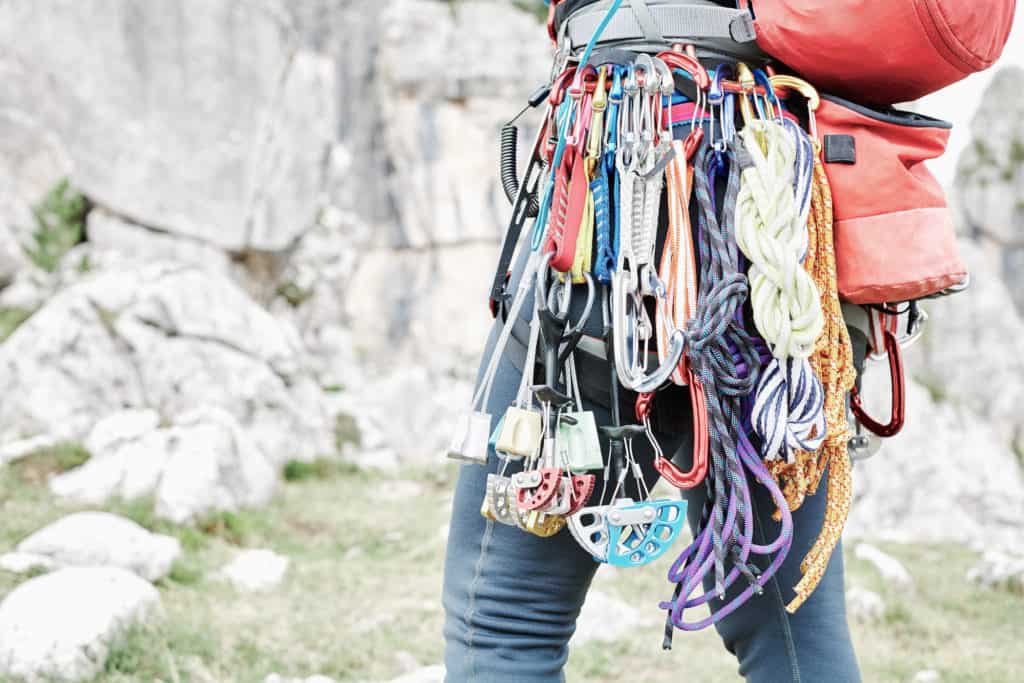
Rock Climbing Gear
Rock climbing gear is essential for any rock climber. Investing in good equipment is crucial as it contributes to the quality of your climbing and your safety.
Belay devices
When you climb with a belay device, there is a person down below belaying you, someone who controls the safety rope and prevents you from falling too far. A belay device is what the belayer uses to keep tension in the rope and protect the climber from steep falls.
The belay device works on rope friction. So it is easy for the belayer to control the rope as he doesn’t need to put too much force to control the rope.
There are several types of belay devices and you will probably master the use of only one of them.
Figure 8 is the most basic and traditional device and primarily used for rappelling. The figure of 8 devices requires more attention and force than the more advanced devices.
Tubular belay devices are very common and suitable for all climbing types. It is easy to use and you can even handle self-belay and double rope techniques.
Assisted-braking belay devices are devices that can lock on the rope when sudden force applies on it, like in the case of a climber falling. In this case, it is easier for the belay to safely control the rope.
Carabiners and quickdraws are basic essential devices as they attach you through your harness to the climbing equipment.
The carabiners tie the belay device to your harness and also can be found on quick-draw units which are small ropes that we use to secure the rope.
A harness is a piece of equipment that hugs you on your hips and upper thighs that holds your weight and secures you through a carabiner to the rope. When falling or lowering to the ground, you’ll find yourself sitting in your harness as you lower.
There are many types of rope that you can choose from. The two main types of rope are dynamic and static. Dynamic ropes have some more give and stretch to absorb the impact of a climber’s fall. Static ropes don’t stretch nearly as much and are more useful for situations when you transport heavy loads up the wall or lower someone who is injured. There are routes in which there are pre-installed static ropes that we use for secured ascents with a “Jumar”, an ascending device. The Jumar can’t move downwards, only upwards, unless we unlock it.
There is a myriad of types of climbing shoes that you can choose from. The three main types are neutral, moderate, and aggressive shoes. Neutral is most relaxed, moderate is slightly downturned, and aggressive shoes are extremely downturned in the toes.
Chalk mainly comes as either a powder or a liquid. Loose chalk, the powder, is the most ubiquitous there is. Then, there’s liquid chalk. Liquid chalk usually lasts longer after each application, but it is also more expensive. Chalk removes moisture from your hands and gives you a better grip as you climb.
Nuts are passive devices that a climber push inside the crack to fit a certain position. When placed correctly, a force that pulls it, can’t displace it and the climber is secured.
Usually, the climber won’t rely on one unit and several nuts or cams will be placed to secure the climber.
This device will help to release a nut from the crack, as sometimes they get stuck.
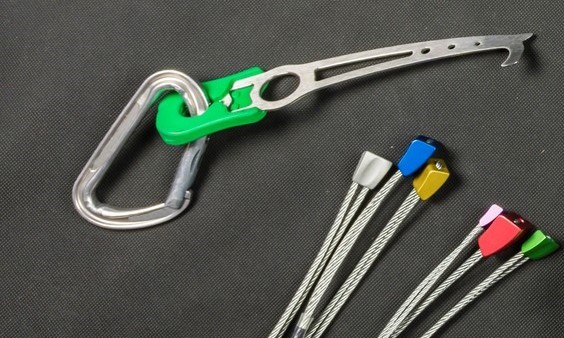
Cams are special equipment that puts higher pressure on a crack when there is a force that pulls it, like in the case of a climber that relies on it, and of course, during a fall.
They come in different sizes, to match different cracks. They are relatively expensive tools but usually, you don’t need to buy a full set to start with.
There are case climbers who use ice-axes when rock climbing. We call it “dry-tooling” and it evolved to be an acceptable technique for an additional type of rock climbing. A Jumar/ascender which is usually found in mountaineering also can be used in some rock climbing routes and as a safety device.
For mixed climbing, the climber should gain mountaineering capabilities, ice climbing capabilities, and rock climbing capabilities. The climber also will need rock and ice climbing gear.
Mixed climbing and ice climbing can be part of the rock climbing day and there are high mountains in which all capabilities and gear come together to ascend the mountain.
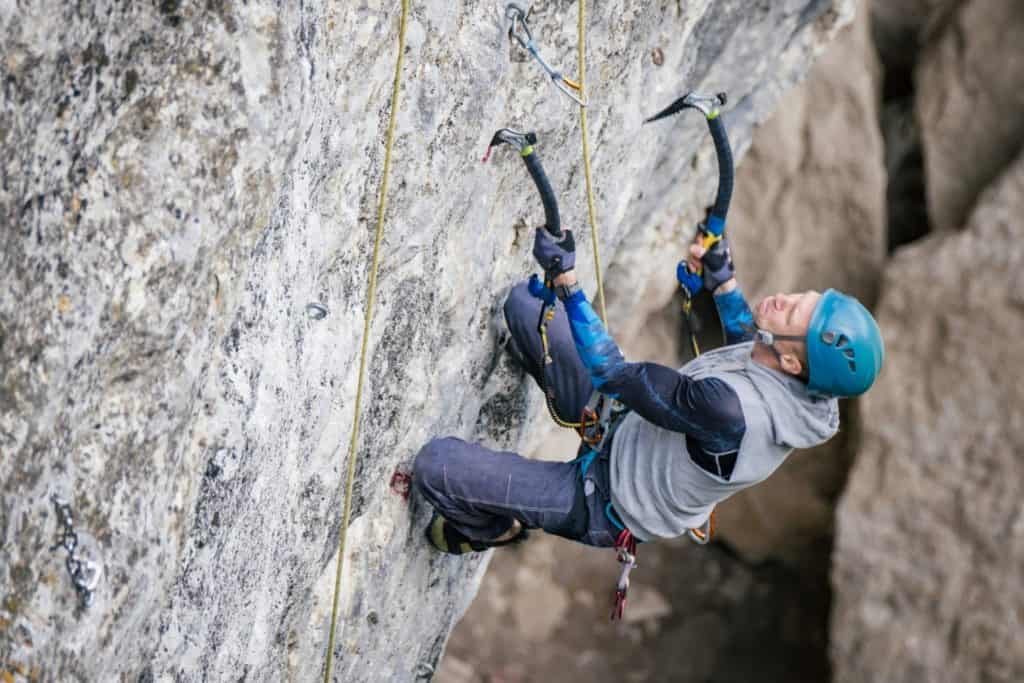
What to Practice
There are several things that climbers need to practice to improve. For beginner to intermediate climbers, climbing at least three times a week is enough for steady improvement. At these levels, climbing is the perfect practice for climbing. As you climb, you naturally increase your finger strength, core strength, and upper body strength. You gain more climbing knowledge and experience that naturally improves you as a climber.
There are a lot of climbing drills that climbers can practice during a climbing session to improve. In order to improve endurance, you can do 4×4 climbs. This means climbing a route or problem below your climbing level four times without taking a break in between each time. Another drill to improve your climbing is by doing a traverse, which means climbing sideways for the length of the climbing wall or around the gym instead of upward. This improves your endurance and footwork, something often overlooked by climbers.
An intermediate level climber should practice and train continously to gain the skills of the more advanced climbers, additional practice and training are required to continue improving past the intermediate level. Advanced climbers also do strength training off the wall. This strength training includes campus training, working on flexibility, and strengthening their upper bodies overall. An advanced climber’s routine often takes inspiration from calisthenics as there is considerable overlap in the exercises.
Warm-up
The warm-up is one of the most essential things that every climber should do, no matter their level. A proper warm-up prevents injuries and increases blood flow, prepping the body to climb at its best. An adequate climbing warm-up involves the entire body. Some key parts of the body that should be focused on, though, are the wrists and shoulders.
If you go to a climbing gym, you’ll see many people with these long rubber bands called resistance bands. Resistance bands are valuable tools for warming up. They strengthen your joints and also improve mobility. One of the reasons why so many climbers use bands is because they are practical and easily portable.
Climbers can also warm up on the climbing wall. It’s an excellent warm-up to climb something a few grades below your climbing level slowly, focusing on technique and all of the tight spots in your body. Warming up on the climbing wall can act as a springboard for proper technique during the rest of your climbing session if you do it properly and carefully.
The most important thing when warming up is to listen to your body. If you find that you don’t feel capable of warming up, then you cannot climb. Instead, take a rest day or focus on your mobility. On the other hand, if you find that one shoulder is tight, for example, work on loosening it up with a few extra minutes of work and then try climbing. A good, short warmup at the beginning of each climbing session can easily prevent months of pain, injury, and headache that skipping it will cost you.
Climbing, like any other sport, requires a proper diet that can maximize your physical potential.
Some climbers are known for having more unique eating habits, such as Alex Megos, who loves incorporating raw carrots
into his diet.
There are also climbers who eat as little as possible to remain light relative to their muscle mass.
The proper diet for climbing should be healthy and balanced. You should eat to have enough energy to climb well, not to stay as light as possible. Despite what many people think, weighing little does not necessarily correlate to climbing well. It’s a pitfall that many fall into: eating less will hinder your climbing, not help it. To optimize your climbing, you have to eat enough
calories.
Something that many climbers ask themselves is if they should eat a vegetarian or vegan diet. A lot of climbers eat this way because it is more sustainable for the environment. Adopting a more plant-based diet can bring some benefits, including fat loss, not feeling “weighed down” by your food, and saving money.
But everyone is different. If you like eating meat, you don’t have to give it up to fuel your climbing. As long as you eat unhealthier foods in moderation, then you don’t have to eliminate them from your diet completely.
During 1-hour of climbing, you can burn anywhere between 500 to 900 calories. Make sure to fuel yourself with enough energy and enough protein to support your muscle’s strength and growth, and the overall demanding activity.
Multivitamin supplements can be essential to support your diet.
For the climbing session, if your climbing site is accessible you are actually not limited to specific foods. You might want to travel lite and to use high nutrient-dense food or protein-energy bars.
Further reading:
Introduction to mountaineering
Altitude Sickness-info, treatment and prevention
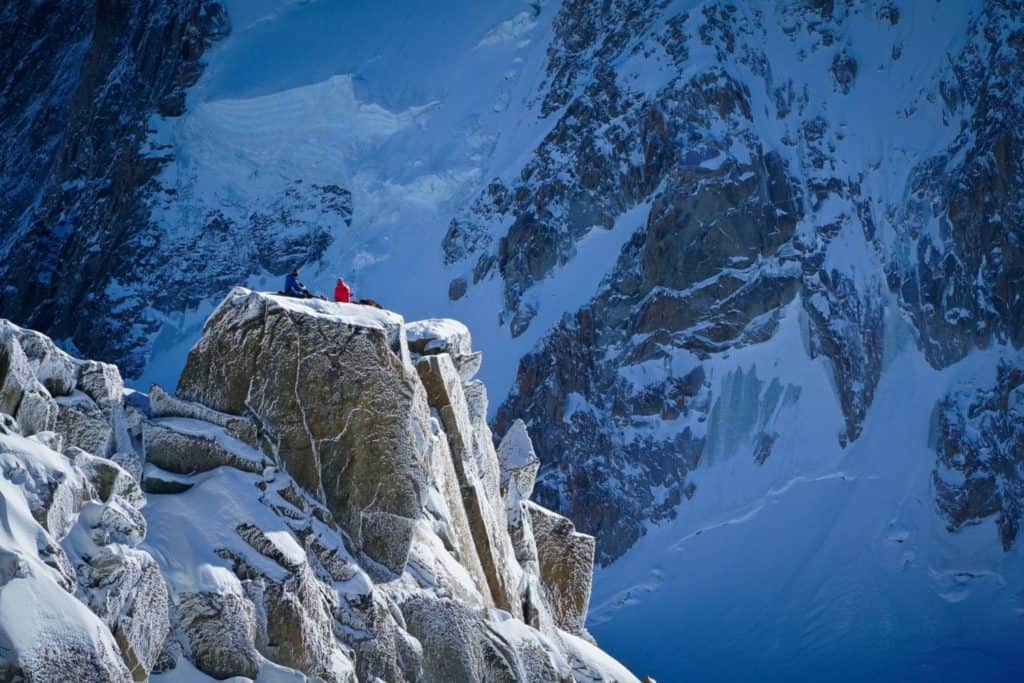
Leave a comment